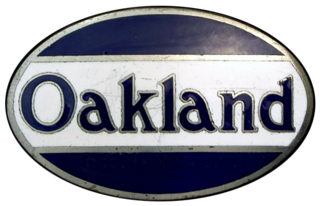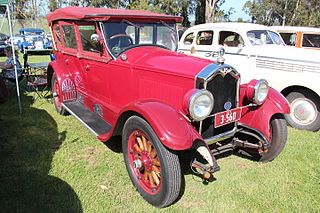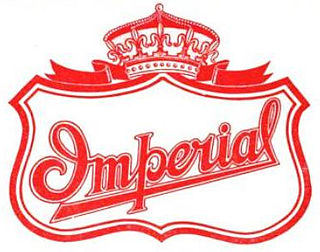Related Research Articles

Buick is a division of the American automobile manufacturer General Motors (GM). Started by automotive pioneer David Dunbar Buick in 1899, it was among the first American marques of automobiles, and was the company that established General Motors in 1908. Before the establishment of General Motors, GM founder William C. Durant had served as Buick's general manager and major investor.

McLaughlin Motor Car Company Limited was a Canadian manufacturer of automobiles headquartered in Oshawa, Ontario. Founded by Robert McLaughlin, it once was the largest carriage manufacturing factory in the British Empire.

William Crapo Durant was a leading pioneer of the United States automobile industry and co-founder of General Motors and Chevrolet. He created a system in which a company held multiple marques – each seemingly independent, with different automobile lines – bound under a unified corporate holding company. Durant, along with Frederic L. Smith, co-founded General Motors, as well as Chevrolet with Louis Chevrolet. He also founded Frigidaire.
The Abadal was a Spanish car manufactured between 1912 and 1923, named after Francisco Abadal. Considered a fast luxury car, it was closely patterned on the Hispano-Suiza and offered in two models. One had a 3104 cc four-cylinder engine while the other had a 4521 cc six-cylinder engine.

The Flint was an automobile marque that was assembled by the Flint Motors Division, Flint, Michigan between 1923 and 1927. Flint Motors was a wholly owned subsidiary of Durant Motors Company.

The Star was an America automobile marque that was assembled by the Durant Motors Company between 1922 and 1928. Also known as the Star Car, Star was envisioned as a competitor against the Ford Model T and Chevrolet. In the United Kingdom, it was sold as the Rugby, to avoid confusion with the British marque.

Mason Motors, founded by A. C. Mason in cooperation with William C. Durant, was a U.S. truck manufacturer based in Flint, Michigan. As a subsidiary of Durant Motors, Mason Truck built Road King Speed Trucks in the early 1920s. Mason Motors also built automobile engines in 1911, who first led Buick's engine works in Flint. That company was absorbed by Chevrolet in 1915, but remained under the Chevrolet umbrella until January 1, 1918, when it became known as the Motor and Axle Division of Chevrolet.

The Oakland Motor Car Company of Pontiac, Michigan, was an American automobile manufacturer and division of General Motors. Purchased by General Motors in 1909, the company continued to produce modestly priced automobiles until 1931 when the brand was dropped in favor of the division's Pontiac make.
Buick City was a name applied to the former Buick home plant following major renovations completed during the early 1980s to better compete with Japanese producers. The plant was a massive automobile manufacturing complex in the northeast of Flint, Michigan. Elements of the 235-acre (950,000 m2) complex dated from before 1904, when it was known as Flint Wagon Works. Once General Motors assumed operations all aspects of Buick vehicles were constructed, and it became known as "Buick City" in 1985. The engine block and cylinder heads were cast at Defiance Foundry in Defiance, Ohio and earlier at Saginaw Metal Casting Operations in Saginaw, Michigan.

Moon Motor Car Company was an American automobile company that was located in St. Louis, Missouri. The company had a venerable reputation among the buying public, as it was known for fully assembled, easily affordable mid-level cars using high-quality parts. Often this meant the manufacturing process required more human intervention, leading to operating losses. The company was founded by carriage maker Joseph W. Moon. Moon produced both cars and trucks.

Marquette was an American automobile manufacturer established by General Motors in 1909 after the purchase of the Rainier Motor Car Company. The Marquette Company did not last long and in 1912 GM announced the company would be closed.
The Little were two automobiles built in Flint, Michigan, from 1912 – 15 and the company, Little Motor Car Company, founded by William H. Little and William C. Durant that built them. It was incorporated into the current Chevrolet Motor Company.

Scripps-Booth was a United States automobile marque based in Detroit, Michigan. Established by James Scripps Booth in 1913, Scripps-Booth Company produced motor vehicles and was later acquired by General Motors, becoming a division of it, until the brand was discontinued in 1923.

The Buick Standard Six Series 20 was manufactured by Buick at the Flint Wagon Works factory of Flint, Michigan, and was the junior model to the Buick Master Six between 1925 through 1929, and shared the GM A platform with Oldsmobile, Oakland and Chevrolet. The Standard Six evolved from the earlier Buick Six when the Buick 4-cylinder was cancelled. The Standard Six was the most popular Buick sold while being more upscale to the Oldsmobile Six. It was the senior brand to Marquette under the General Motors Companion Make Program until Marquette was cancelled one year later. It replaced the earlier Buick Six that was introduced in 1916, and was replaced with the Buick Series 50. Coachwork continued to be offered by Fisher Body who was the primary supplier of all GM products at this time, and Duco automotive lacquer paint, introduced by DuPont was the first quick drying multi-color line of nitrocellulose lacquers made especially for the automotive industry.
Pontiac Assembly was one of four General Motors assembly plants in Pontiac, Michigan located along Baldwin Avenue. It served as the home factory for GM's Pontiac Motor Division since it was built in 1927. It was across the street from the currently operational Pontiac Metal Center, which was the original location for the Oakland Motor Car Company, which Pontiac evolved out of.

The Imperial Automobile Company of Jackson, Michigan, was formed by the brothers T. A. and George N. Campbell in 1908, who also ran the Jackson Carriage Company.

The Buick 4 was a series of passenger cars produced by the Buick Division of GM from 1909 through 1918, and was available as a touring car, phaeton or roadster. It was available with the Buick Model B as a larger alternative offering a larger engine and better durability. It became the junior sedan in 1914 when the Buick Six was introduced.
Flint Wagon Works of Flint, Michigan, manufactured wagons from the early 1880s. One of the world's most successful horse-drawn vehicle makers they formed with their Flint neighbours a core of the American automobile industry. In 1905 Flint was promoting itself as Flint the Vehicle City. The former site is now located in the neighborhood of Flint known as "Carriagetown".

The Oldsmobile Six, also known as the Model 53, 54 and 55 (1913-1915) then a brief cancellation until it reappeared as the Model 37, 37A and 37B (1917-1921) was a top level sedan along with the Oldsmobile Series 40 junior vehicle produced by GM's Oldsmobile Division and was manufactured at Lansing Car Assembly in Lansing, Michigan. It replaced the Series 28 also known as the "Oldsmobile Autocrat" and was replaced by the Oldsmobile Model 30 in 1927, and shared wheelbases with the Buick Six. It continued to use the T-head engine for two years. The various bodystyles were supplied by Fisher Body of Detroit, MI. It competed with the Chevrolet Series C Classic Six as Chevrolet was an independent company before becoming a division in 1917. Oldsmobile also shared technology with GMC for commercial and industrial products.

The Buick 60 Special is an early American racing car, two of which were built by Buick in 1910. It is one of the first US-built cars with just a single seat for the driver that was centrally located. The car is nicknamed the Buick Bug.
References
- 1 2 3 Kimes, Beverly (1996). Standard catalog of American Cars 1805–1942 (third ed.). Krause publications. p. 780. ISBN 0-87341-478-0.
- ↑ Georgano, G. N., ed. (1982). The New Encyclopedia of Motorcars — 1885 to the Present. E. P. Dutton. p. 335. ISBN 0-525-93254-2.
- ↑ Brazeau, Mike (21 May 2008). "Buick Model 10". Archived from the original on 24 January 2017.
